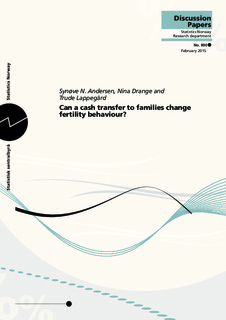| dc.contributor.author | Andersen, Synøve Nygaard | |
| dc.contributor.author | Drange, Nina | |
| dc.contributor.author | Lappegård, Trude | |
| dc.coverage.spatial | Norway | nb_NO |
| dc.date.accessioned | 2019-11-11T09:54:14Z | |
| dc.date.available | 2019-11-11T09:54:14Z | |
| dc.date.issued | 2015-02 | |
| dc.identifier.issn | 1892-753X | |
| dc.identifier.uri | http://hdl.handle.net/11250/2627621 | |
| dc.description.abstract | This paper assesses the relationship between cash transfers to families and subsequent childbearing. We take advantage of a cash-for-care (CFC) policy introduced in Norway in 1998, and compare the fertility behaviour of eligible and ineligible mothers over a four year period. Contrary to theoretical expectations, the results show that CFC eligible mothers had a slower progression to both second and third births, and short term fertility is hence lower in this group. The patterns differ somewhat between different groups of mothers, and there seems to be a polarisation between nonemployed mothers and mothers without upper secondary education, on one hand, and employed mothers and mothers with upper secondary and higher education, on the other. We suggest that this pattern may be driven by an interaction between the CFC benefit and the Norwegian parental leave scheme. | nb_NO |
| dc.description.sponsorship | Norwegian Research Council [grant number 217915] | nb_NO |
| dc.language.iso | eng | nb_NO |
| dc.publisher | Statistisk sentralbyrå | nb_NO |
| dc.relation.ispartofseries | Discussion papers;800 | |
| dc.subject | JEL classification: J10 | nb_NO |
| dc.subject | JEL classification: J13 | nb_NO |
| dc.subject | JEL classification: J18 | nb_NO |
| dc.title | Can a cash transfer to families change fertility behaviour? | nb_NO |
| dc.type | Working paper | nb_NO |
| dc.description.version | publishedVersion | nb_NO |
| dc.subject.nsi | VDP::Matematikk og Naturvitenskap: 400::Matematikk: 410::Statistikk: 412 | nb_NO |
| dc.source.pagenumber | 33 | nb_NO |
